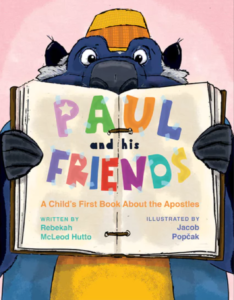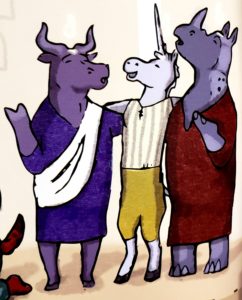 Last year, a delightfully illustrated children’s book was released, introducing young readers to the leaders of the early church. Paul and His Friends: A Child’s First Book about the Apostles, written by Rebekah McLeod Hutto and illustrated by Jacob Popčak, is a feast for the eyes and a much-needed addition to Sunday school bookshelves.
Last year, a delightfully illustrated children’s book was released, introducing young readers to the leaders of the early church. Paul and His Friends: A Child’s First Book about the Apostles, written by Rebekah McLeod Hutto and illustrated by Jacob Popčak, is a feast for the eyes and a much-needed addition to Sunday school bookshelves.
With Paul as their traveling guide and narrator, children meet Paul’s network of friends and learn about their contributions to the life of the early church: the hospitality of Ananias, the leadership of Lydia, the faith of Timothy, and more.
The imagination of Jacob Popčak brings each of Paul’s friends to life as an animal, chosen specifically to illustrate certain characteristics of each friend. (Priscilla and Aquila are wise elephants. Timothy is a shy gazelle.) The illustrations truly make Paul and His Friends stellar. From a camel to a badger, a hyena to a rhino (or a unicorn?), the early church leaders are shown to be as diverse as they surely were across the regions to which Paul travels.
The story itself is really two-in-one, which creates an awkward trip for the reader at the juncture of the two. The book’s first theme — Paul’s introduction of his friends in the early church — yields to a second theme — Jesus’ lessons on friendship — without clear transition of the narrative perspective as Paul’s first-person voice goes missing for four pages. (Is it Paul who’s reflecting on Jesus’ ministry? Is it the book/author who’s inserting this lesson about Jesus?) I suppose it’s an odd observation to say that Jesus is misplaced in a story about the church … but in this particular book, the interrupted narrative does indeed read as though Jesus is an obligatory afterthought.
 That said, Paul and His Friends could be an excellent basis for a three-lesson series on friendship, whether in Sunday school or children’s sermons, using those odd breaks in the narrative to distinguish the three lessons:
That said, Paul and His Friends could be an excellent basis for a three-lesson series on friendship, whether in Sunday school or children’s sermons, using those odd breaks in the narrative to distinguish the three lessons:
- Learning the names of the early church leaders as introduced by Paul, and remembering that it takes many people (friends) to work together to lead the Church;
- Discussing the actions that comprise friendship, including the ways we respond when one friend hurts or disappoints another;
- Highlighting the diverse gifts that we all bring to friendship, using the book’s epilogue about animal characters to celebrate each child’s unique personality and participation in community.
Paul and His Friends is a visual delight and a useful educational tool, which will be an asset to many bookshelves in homes and churches!
